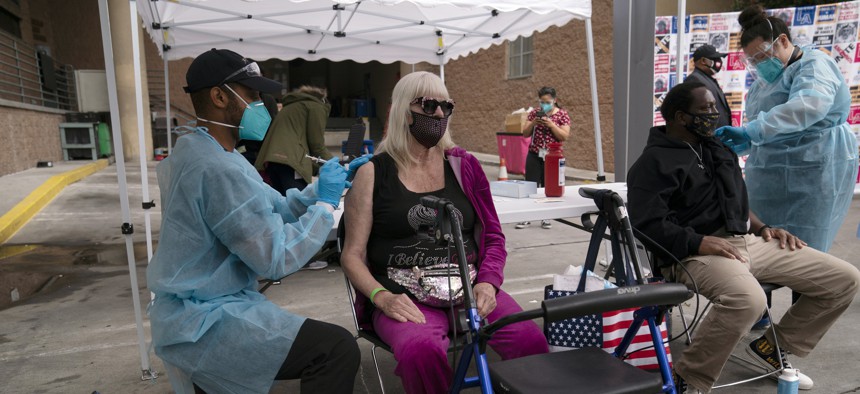Cities Direct Johnson & Johnson Vaccine to Homeless Populations

A nurse administers a COVID-19 vaccine to Connie Lach, 66, at a vaccination site set up in the parking lot of the Los Angeles Mission in the Skid Row area of Los Angeles, Wednesday, Feb. 10, 2021. AP Photo/Jae C. Hong
There are practical reasons why it makes sense to use the one-dose vaccine for hard-to-reach groups, but experts say the practice can also fuel skepticism and concern if public officials aren’t careful.
City health departments across the country are planning to use the newly approved Johnson & Johnson coronavirus vaccine to target homeless and other hard-to-reach populations—touting the easy logistics with the single-dose shot.
But to avoid sewing confusion and distrust among the public, health experts caution that officials need to be transparent about the reasons why certain groups are getting a specific brand of the vaccine. They emphasize that all three vaccines currently approved in the U.S. work well and will decrease the likeliness or severity of an infection.
Milwaukee Mayor Tom Barrett said 2,000 doses of the Johnson & Johnson vaccine will be administered at homeless shelters throughout the city beginning next week.
“One of the things that came to our attention was the challenge with the transient population that sometimes resides in our shelters and sometimes moves on someplace else,” Barrett said during a press conference this week.
The Moderna and Pfizer vaccines both require two shots to achieve maximum effectiveness against the virus, and officials said it can be difficult to locate homeless residents to administer second doses. Another upside with the Johnson & Johnson vaccine is that it can be stored in a regular refrigerator, whereas the Pfizer and Moderna vaccines must be kept at super cold temperatures. That makes it easier for public health officials to travel out into the community with the doses.
"This is obviously attractive for those at the shelter," Barrett said. "That's a place we think we can have a lot of positive impact."
Public health officials in Louisville, Kentucky said they also plan to target the Johnson & Johnson vaccine to populations that have otherwise been difficult to vaccinate.
“We will likely be deploying that in a more intentional and direct way into the community, focusing initially on those transitory folks who are at high-risk, like our homeless population and others,” said Dr. SarahBeth Hartlage, the medical director of the city’s Department of Public Health and Wellness, during a press briefing this month.
The city’s drive-in mass vaccination site will continue to offer the other two vaccine brands, while the Johnson & Johnson doses will be set aside for use elsewhere, she said.
Concerned by the disproportionate rate at which the virus was affecting communities of color and underserved populations, state and local governments have also taken steps to improve the equity of their coronavirus response plans.
There are obvious practical reasons why public health departments would target the one-dose vaccine to hard-to-reach populations, said Lois Privor-Dumm, policy director at the International Vaccine Access Center at Johns Hopkins Bloomberg School of Public Health. But to avoid misperceptions, officials need to engage with the community to ensure residents understand why they are doing so.
“As soon as you start giving one population one thing and another population another thing, people will always question why are they getting that?” Privor-Dumm said. “So, we have to be really transparent in that we are getting out the vaccine to different places based on what vaccine happens to be available.”
Some cities and states have also turned to the new Johnson & Johnson doses to meet demand as they expand vaccine eligibility to new groups.
Pennsylvania is prioritizing teachers for the Johnson & Johnson vaccine as they work toward getting students back in classrooms. San Francisco began administering it to teachers this week. And, citing the ease of storing and transporting the Johnson & Johnson vaccine, New York City launched a new program to vaccinate homebound seniors.
But negative perceptions about the efficacy of the Johnson & Johnson vaccine led one city to initially reject the product.
Detroit Mayor Mike Duggan turned away 6,000 doses of the single-dose shot last week, saying he wanted to “make sure residents of the city of Detroit get the best." Duggan later reversed his stance and acknowledged that he did not have all the research about vaccine efficacy rates when he spoke.
While initial studies showed the Johnson & Johnson vaccine is slightly less effective at preventing Covid-19 infection than the other two, public health professionals urge people to take whichever brand is available.
“When it’s your turn to get vaccinated, we urge you to take the first vaccine available to you,” said Susan Bailey, president of the American Medical Association.
Demand for the coronavirus vaccine still drastically outpaces supply, so many jurisdictions are administering whatever brand of it they have on hand.
“Right now, when you go to particular sites you don’t really know what vaccine you are going to get. And that’s probably a good thing,” Privor-Dumm said.
Andrea Noble is a staff correspondent with Route Fifty.
NEXT STORY: State and Federal Wildlife Officials Would Like You to Please Destroy Your Moss Balls





